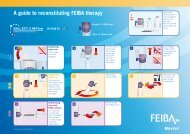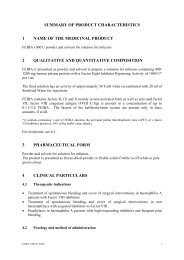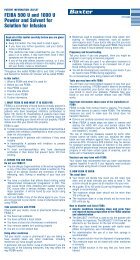FEIBA Patient Information Booklet - Haemophilia Care
FEIBA Patient Information Booklet - Haemophilia Care
FEIBA Patient Information Booklet - Haemophilia Care
You also want an ePaper? Increase the reach of your titles
YUMPU automatically turns print PDFs into web optimized ePapers that Google loves.
Baxter Healthcare Ltd, Wallingford Road, Compton,<br />
Newbury, Berks RG20 7QW.<br />
Tel: 01635 206000. Fax: 01635 206373<br />
Baxter and <strong>FEIBA</strong> are registered trademarks of<br />
Baxter International Inc., its subsidiaries and affiliates<br />
www.baxterhealthcare.co.uk<br />
www.haemophiliacare.co.uk<br />
About <strong>FEIBA</strong> and Inhibitors<br />
Date of preparation: September 2009. ADV09/2617B
<strong>FEIBA</strong> and inhibitors<br />
If you or someone you care for has been told they have an inhibitor,<br />
you may understandably have some questions and concerns about<br />
how this will affect you and your family.<br />
Thankfully, treatment has come a long way in recent years and today<br />
inhibitor patients and their families can generally manage treatment<br />
themselves and continue with daily activities.<br />
<strong>FEIBA</strong> has been used for inhibitor treatment for over three decades,<br />
which means that there is a long history of clinical data to support its use.<br />
This booklet has been designed for patients who have been prescribed<br />
<strong>FEIBA</strong>. It will provide you with comprehensive information about <strong>FEIBA</strong><br />
treatment and inhibitors. However, if you have any further questions,<br />
please make a note of them to discuss with your Doctor or Nurse at<br />
your next appointment.<br />
Contents<br />
Introduction to inhibitors 4<br />
From hospital to home: the evolution of inhibitor treatment 5<br />
What is <strong>FEIBA</strong>? 6<br />
How does <strong>FEIBA</strong> work? 6<br />
Who can use <strong>FEIBA</strong>? 7<br />
What dose of <strong>FEIBA</strong> should I take? 8<br />
Why is it important that I keep taking <strong>FEIBA</strong>? 9<br />
What are the potential side-effects? 9<br />
Using <strong>FEIBA</strong> safely 10<br />
What should I do if I take too much <strong>FEIBA</strong>? 10<br />
What should I do if I miss a dose of <strong>FEIBA</strong>? 10<br />
What’s inside a <strong>FEIBA</strong> pack? 11<br />
Preparing <strong>FEIBA</strong> for use 12<br />
How should I store <strong>FEIBA</strong>? 16<br />
How should I dispose of unused solution and waste material? 17<br />
Protecting patients: the Baxter plasma safety programme 18<br />
Further information 23<br />
3
Introduction to inhibitors<br />
<strong>Patient</strong>s with haemophilia generally receive treatment (known as<br />
‘factor replacement therapy’) to help their blood to clot.<br />
Some patients develop antibodies to their haemophilia treatment.<br />
Antibodies are produced by the immune system to destroy substances<br />
the body perceives as foreign.<br />
The antibodies to haemophilia treatment are known as ‘inhibitors’.<br />
The inhibitor neutralises the haemophilia treatment and prevents it<br />
from doing its job.<br />
Inhibitors stop haemophilia treatment<br />
from doing its work<br />
From hospital to home:<br />
the evolution of inhibitor treatment<br />
The good news is that today there are many things that<br />
can be done to help people who develop inhibitors.<br />
Immune Tolerance Induction (ITI)<br />
When an inhibitor is first detected, ITI may be tried in order to eliminate it.<br />
The idea behind this is to infuse haemophilia treatment in high doses on<br />
a regular basis (sometimes as often as twice a day) so that the body will get<br />
used to the treatment and stop producing antibodies.<br />
Next Steps<br />
If ITI is unsuccessful, the patient will receive a treatment such as <strong>FEIBA</strong>.<br />
Treatment can either be given as a regular infusion (‘prophylaxis’) in order<br />
to try and prevent the bleed from occurring or be given to control the<br />
bleed when it occurs (‘on- demand’ treatment).<br />
A treatment such as <strong>FEIBA</strong> can also be used to treat breakthrough bleeds<br />
during ITI.<br />
Treatment At Home<br />
<strong>Patient</strong>s on <strong>FEIBA</strong> treatment may be able to manage their treatment at home.<br />
This has been a truly life-changing advance. Being able to treat the bleed at<br />
the time it starts means that the bleed can be controlled faster. It also means<br />
that you may not need to go to your <strong>Haemophilia</strong> Centre for every treatment.<br />
Guidance of how to treat a bleeding episode will be given by your care team<br />
at the centre. Treating within the home environment will help to free up time<br />
and means much less disruption to schooling or work and, perhaps most<br />
importantly, gives you more time to get on with the things you want to do.<br />
4<br />
5
What is <strong>FEIBA</strong>?<br />
<strong>FEIBA</strong> is derived from human plasma and permits blood clotting in haemophilia<br />
patients with inhibitors. <strong>FEIBA</strong> has over 30-years history of effectively<br />
controlling bleeding in haemophilia patients with inhibitors, an established<br />
safety profile and a convenient dosing schedule (see page 8).<br />
How does <strong>FEIBA</strong> work?<br />
Inhibitors neutralise the infused haemophilia treatment and prevent blood<br />
from clotting. <strong>FEIBA</strong> is able to bypass the inhibitors and enable the blood<br />
to form a stable clot and stop bleeding at the site of injury.<br />
Who can use <strong>FEIBA</strong>?<br />
• <strong>FEIBA</strong> is prescribed for the control of spontaneous bleeding episodes<br />
or to cover surgical interventions in patients with congenital haemophilia A<br />
with inhibitors<br />
• <strong>FEIBA</strong> may also be given to help prevent bleeding episodes (prophylaxis)<br />
in patients with haemophilia A and inhibitors who suffer from frequent<br />
joint bleeding<br />
• <strong>FEIBA</strong> is also prescribed for treatment of spontaneous bleeding and<br />
cover of surgical interventions in patients with acquired haemophilia A<br />
• <strong>FEIBA</strong> may be used to treat bleeds that can occur during ITI treatment<br />
(ITI is a treatment aimed at eradicating the inhibitor)<br />
6<br />
7
Why is it important that I keep<br />
taking <strong>FEIBA</strong>?<br />
When medication has been prescribed, it is important to continue taking<br />
it regularly as recommended by your <strong>Haemophilia</strong> Centre, as this will reduce<br />
the risk of ‘spontaneous’ bleeds. Prophylactic treatment enables patients to<br />
get on with their lives more easily.<br />
For those with haemophilia, prophylaxis can prevent bleeds and joint damage,<br />
which can be painful and debilitating. By protecting joints the likelihood of<br />
requiring orthopaedic surgery later in life can also be reduced.<br />
What dose of <strong>FEIBA</strong> should I take?<br />
Your haemophilia Doctor or Nurse will give you clear guidance as to the dose<br />
you need and how often you should infuse.<br />
For regular infusions (prophylaxis) the recommended dose is 50–100 units per<br />
kilogram of body weight from daily to three times a week. When administered<br />
during ITI, a daily dose of 50 U/kg body weight may be sufficient.<br />
For prophylactic treatment, <strong>FEIBA</strong> can be infused as regularly as daily or as<br />
little as three times a week. <strong>Patient</strong>s will be treated individually to assess their<br />
needs. Regular appointments to track progress and assess symptoms will<br />
enable your haemophilia care team to ensure you are using the optimum dose.<br />
What are the potential<br />
side-effects?<br />
As with all injected products, allergic reactions are possible. As a result<br />
the most frequently reported side-effects of <strong>FEIBA</strong> include allergic and<br />
hypersensitivity reactions such as shortness of breath, hives, rash<br />
and flushing.<br />
Rarely, other more serious side-effects may occur. Please read the<br />
leaflet inside your <strong>FEIBA</strong> packaging carefully and seek medical attention<br />
immediately if you become concerned about any potential reactions<br />
to <strong>FEIBA</strong>.<br />
To treat a spontaneous bleed (on-demand treatment), you will be given clear<br />
guidance by your haemophilia care team, as the dose and dosing interval will<br />
depend on the nature and severity of the bleed. Depending on the nature<br />
of the bleed and how confident you feel about home infusion, you may need<br />
to go to your <strong>Haemophilia</strong> Centre to deal with a spontaneous bleed.<br />
8<br />
9
Using <strong>FEIBA</strong> safely<br />
• Generally, an infusion of <strong>FEIBA</strong> should not exceed 100 units per kg of<br />
body weight for a single dose, or a total dose of 200 units per kg of body<br />
weight per day. Please see page 8 for recommended <strong>FEIBA</strong> doses for<br />
prophylactic treatment and treatment during ITI<br />
• <strong>FEIBA</strong> should not be given to people with a normal blood<br />
clotting mechanism<br />
What should I do if I take too<br />
much <strong>FEIBA</strong>?<br />
Heart and circulation problems have been observed with overdoses of<br />
<strong>FEIBA</strong>. If you have any concerns please contact your doctor immediately.<br />
What’s inside a <strong>FEIBA</strong> pack?<br />
If you receive your <strong>FEIBA</strong> treatment in the <strong>Haemophilia</strong> <strong>Care</strong> Centre<br />
they have access to all the ancillaries needed for infusion.<br />
If <strong>FEIBA</strong> is delivered to your home with the Baxter Factor Direct Home<br />
Delivery Service, you can ask for the ancillaries needed for infusion<br />
(free of charge) to be delivered at the same time as your <strong>FEIBA</strong>.<br />
It is recommended that a Iuer lock syringe is used (this is not included<br />
in the <strong>FEIBA</strong> pack)<br />
15-25 0 C<br />
What should I do if I miss my<br />
dose of <strong>FEIBA</strong>?<br />
Do not take double your dose. Take the next dose immediately and<br />
continue future doses at the regular intervals your doctor has advised.<br />
Wash hands.<br />
Bring the vials to room temperature.<br />
Remove caps from vials.<br />
Wipe vial tops with alcohol swabs and let dry.<br />
10<br />
11
5<br />
10<br />
15<br />
20<br />
ml<br />
Preparing <strong>FEIBA</strong> for use<br />
As easy as 1, 2, 3<br />
A guide to reconstituting <strong>FEIBA</strong> therapy<br />
1<br />
Connecting<br />
1a<br />
2<br />
water vial<br />
Do not remove<br />
device from<br />
packaging.<br />
2a<br />
Connecting<br />
<strong>FEIBA</strong> vial<br />
Turn device over<br />
and connect<br />
purple side of<br />
device to <strong>FEIBA</strong><br />
vial. Press down<br />
until purple spike<br />
pierces<br />
vial stopper.<br />
1b<br />
On a flat surface,<br />
connect clear<br />
side of device<br />
to water vial.<br />
Press down<br />
until clear<br />
spike pierces<br />
vial stopper.<br />
2b<br />
Swirl gently to<br />
dissolve <strong>FEIBA</strong>.<br />
1c<br />
Grip packaging<br />
at edge and lift it<br />
off, leaving device<br />
connected to<br />
water vial.<br />
2c<br />
Latex-free<br />
Remove blue cap<br />
from device and<br />
attach syringe.<br />
Do not inject air.<br />
12<br />
13
5<br />
5<br />
10<br />
10<br />
15<br />
15<br />
20<br />
ml<br />
20<br />
ml<br />
Preparing <strong>FEIBA</strong> for use<br />
As easy as 1, 2, 3<br />
A guide to reconstituting <strong>FEIBA</strong> therapy<br />
3<br />
3a<br />
Latex-free<br />
Withdrawing<br />
dissolved <strong>FEIBA</strong><br />
solution<br />
Turn device over<br />
so empty water<br />
vial is at the bottom.<br />
Slowly pull back<br />
on syringe plunger<br />
to withdraw <strong>FEIBA</strong><br />
solution.<br />
3b<br />
Remove syringe<br />
with <strong>FEIBA</strong><br />
solution.<br />
Latex-free<br />
Disconnect the BAXTECT II Hi-Flow from the syringe and attach a winged<br />
infusion set. Hold the needle above the syringe and get rid of any excess<br />
air from the line before infusing the <strong>FEIBA</strong> solution. Slowly inject the<br />
solution intravenously.<br />
DO NOT EXCEED AN INJECTION/INFUSION RATE OF 2 UNITS OF <strong>FEIBA</strong><br />
PER KG OF BODY WEIGHT PER MINUTE<br />
14<br />
15
How should I store <strong>FEIBA</strong>?<br />
<strong>FEIBA</strong> should be stored in a refrigerator between 2° and 8°C. It should not<br />
be frozen.<br />
Within the indicated shelf life, you can also store <strong>FEIBA</strong> at room temperature<br />
(up to 25°C) for a period of 6 months or up to 2 years if it is in the<br />
refrigerator. When storing <strong>FEIBA</strong> at room temperature it is important that<br />
you write the new expiry date on the box. At the end of this period the<br />
product must be used, discarded or returned to the <strong>Haemophilia</strong> Centre.<br />
You must not return it to the fridge following storage at room temperature.<br />
Keep the vials in the box in order to protect them from light.<br />
Mix the <strong>FEIBA</strong> just before you are going to use it. The solution should be<br />
used immediately. You must only use solutions that are clear and not cloudy<br />
or containing any particles. If you are unsure, please contact your<br />
<strong>Haemophilia</strong> Centre for advice.<br />
How should I dispose of unused<br />
solution and waste material?<br />
When a home delivery service is used, they will normally take away unused<br />
solution and waste material. Your haemophilia care team will show you<br />
how to store these materials in the bins provided until it is removed by the<br />
delivery team.<br />
Any unused solution and waste material should be disposed of carefully<br />
to avoid any risk of injury to others. All equipment used for the infusion<br />
and its preparation should be disposed of directly into a sharps bin that can<br />
be sealed when it is three quarters full. Your haemophilia care team will give<br />
guidance on the safe storage and disposal of your infusion materials.<br />
Normally when <strong>FEIBA</strong> is delivered by a home delivery service, you can<br />
simply order replacement sharps bins from your coordinator and return<br />
your sealed sharps bins by handing them to the delivery driver.<br />
16<br />
17
Protecting patients: the Baxter<br />
plasma safety programme<br />
In the production of plasma-derived treatments such as <strong>FEIBA</strong>, patient safety<br />
is of paramount importance.<br />
By adhering to the most stringent plasma safety regulations, Baxter is<br />
exceeding standard industry practices, dedicating efforts to advancing plasma<br />
safety. In fact, Baxter is a world leader in all aspects of plasma-derived<br />
therapeutic safety from initial donor selection to final product formulation.<br />
We source plasma from our own plasmapheresis centres or from centres<br />
that meet Baxter standards. Our plasma screening standards meet or exceed<br />
all industry and regulatory requirements.<br />
As a result, you can be confident that everything possible has been done<br />
to ensure the safety of <strong>FEIBA</strong>.<br />
Protecting patients: the Baxter<br />
plasma safety programme<br />
Our safety measures include<br />
• One of the first companies to receive QSEAL (Quality, Standards of<br />
Excellence, Assurance, and Leadership) certification which recognises<br />
the company’s commitment to outstanding quality and safety in<br />
plasma sourcing and manufacturing<br />
Strict selection of plasma donors according to the<br />
Qualified Donor Standard<br />
• All donor applicants have to go through two sets of screening interviews<br />
(covering case history, high-risk behaviour inquiry, physical examination)<br />
and laboratory tests before being a qualified donor<br />
• All donations made by donors that do not come back for a second<br />
donation are automatically discarded<br />
60-day inventory hold period of all plasma donations<br />
to ensure safety of donation<br />
• The inventory hold period allows each donation to be virus-tested<br />
(and discarded if positive) before it goes into the manufacturing process<br />
• It also gives sufficient time to receive post-donation information about<br />
donor and to discard any single donations<br />
18<br />
19
PCR and Serology testing of plasma<br />
• PCR testing is performed on sample donations to detect virus genomes<br />
• Small samples are pooled and only those that are PCR-negative are<br />
allowed to enter the production pool. Positive samples are isolated and<br />
destroyed along with any previous samples provided by the donor.<br />
The donor is then rejected from future donations<br />
• Prior to using a plasma production pool for <strong>FEIBA</strong> production, further PCR<br />
testing is conducted in Baxter’s dedicated Serology laboratories in Vienna<br />
NAT (nucleic acid amplification technology) testing<br />
for assurance<br />
• Allows detection of certain viruses earlier than current serological<br />
screening methods<br />
Vapour Heat treatment for inactivation of viruses<br />
• During the manufacturing process, <strong>FEIBA</strong> also undergoes a two-step<br />
vapour heat treatment which destroys potential viruses without destroying<br />
the product<br />
Leading the way<br />
in patient protection<br />
Since the early 1990s, our experts have been leading the way in Plasma<br />
Safety, pioneering many key innovations that have increased the quality<br />
and safety of plasma products.<br />
Many other companies have adopted our plasma inventory hold and<br />
Qualified Donor Programme standards.<br />
Plasma Master File<br />
Baxter collaborated with European authorities to develop the concept<br />
of the Plasma Master File, which was officially adopted in 1994.<br />
In 2001 Baxter was one of the first companies to receive the Plasma Protein<br />
Therapeutics Association (PPTA) certification of compliance with the<br />
International Quality of Standards of Excellence, Assurance and Leadership<br />
(QSEAL) Program, which recognizes the company’s commitment to<br />
outstanding quality and safety in plasma sourcing and manufacturing.<br />
Nanofiltration of viruses<br />
• As well as vapour heat treatment, nanofiltration takes place during the<br />
manufacturing process. Nanofiltration means that in the unlikely event that<br />
viruses are still present in the raw material, they will be removed via very<br />
fine filters<br />
Every stage of the manufacturing process for <strong>FEIBA</strong>,<br />
from donor to patients, is subjected to the most rigorous<br />
quality control and quality assurance standards<br />
20<br />
21
Unrivalled commitment<br />
to plasma safety<br />
Production safety in state-of-the-art manufacturing facilities using<br />
processes with validated virus reduction capacity.<br />
Continuing research, development and introduction of improved safety<br />
measures, under the direction of The Baxter Global Pathogen Safety Group.<br />
Further information<br />
For further information on <strong>FEIBA</strong> please see your package insert or contact<br />
your <strong>Haemophilia</strong> Centre.<br />
For information on getting your <strong>FEIBA</strong> delivered to you at home, contact your<br />
<strong>Haemophilia</strong> Centre for advice.<br />
Further information on haemophilia and related bleeding disorders is<br />
available from The <strong>Haemophilia</strong> Society at www.haemophilia.org.uk<br />
The Inhibitor Group is run under the umbrella of the <strong>Haemophilia</strong> Society<br />
in the UK.<br />
The <strong>Haemophilia</strong> Society provides information, support and advocacy<br />
for people affected by haemophilia and related bleeding disorders.<br />
Freephone helpline: 0800 018 6068 (Monday – Friday, 10am – 4pm)<br />
Email: info@haemophilia.org.uk<br />
Explore www.haemophiliacare.co.uk/feiba to find information about<br />
inhibitors, <strong>FEIBA</strong> and details regarding the Inhibitor Group.<br />
All data is reviewed by haemophilia specialists.<br />
22<br />
23








